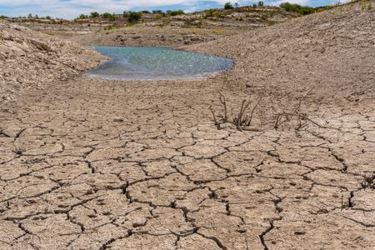Freshwater Disappearing At Alarming Rate: Study

By Christian Bonawandt
For a planet that is 71% water, Earth is in a shockingly short supply of drinking water sources. Freshwater comprises only about 3% of all water, and less than half of that is accessible to humans. New research published in the journal Science Advances reveals that this meager quantity has been rapidly dwindling for more than 20 years due to a combination of factors related to both climate and direct human activity. Using NASA Gravity Recovery and Climate Experiment (GRACE) satellite data, the research shows that areas experiencing drying have been expanding at a dangerous rate since 2002, depleting available drinking water for 75% of the world’s population and contributing to rising sea levels.
According to the report, the single largest threat to terrestrial water storage (TWS) in non-glacial regions is groundwater depletion. Over-pumping of groundwater accounts for 68% of TWS losses, which exacerbates the impacts of rising temperatures, aridification, and extreme drought events. This is especially noticeable in California's Central Valley, the southern Ogallala Aquifer, the Northwestern Sahara Aquifer System, the Arabian Aquifer System, and the Tarim, Indus, Ganges-Brahmaputra, and North China Aquifer Systems. In many areas, groundwater is being depleted at unsustainable or even increasing rates. “It’s like this sort of creeping disaster that has taken over the continents in ways that no one was really anticipating,” Jay Famiglietti, one of the study’s co-authors, told ProPublica.
Even worse, much of the extracted groundwater is discharged back into the ocean. Not only does this make it harder to use for drinking water, but it is also contributing to rising sea levels. Since 2015, freshwater discharges have become the primary source (44%) of rising sea levels, surpassing the melting ice sheets in Greenland (37%) and the Antarctic (19%).
But irresponsible handling of groundwater is far from the only factor impacting existing and potential drinking water supplies. High-latitude water losses, particularly in Canada and Russia, are happening due to rising temperatures and declining precipitation. The study shows that these areas are warming at approximately four times the global average rate, leading to drying of subarctic lakes and persistent drought in regions like the Canadian prairies. Extreme drought events in Central America and Europe over the past several years have been another significant driver. These include catastrophic droughts in Europe — some of the worst in 2000 years — that are influenced by climate change, as well as widespread drying across North Africa. The same factors causing extreme drought are also causing declines in surface water, such as rivers and lakes, which account for 18% of TWS losses. The result is what the authors call “mega-drying regions”, which have been spreading across Earth’s mid-latitudes. These are areas where drying hot spots have overlapped, accelerating the problem for all those who live in and around them. The study has identified one or more mega-drying regions on nearly every continent.
Looking ahead, the authors foresee concerning conditions. The report predicts the rates of continental drying will increase in the coming decades, leading to an accelerated decline in freshwater availability. Moreover, there is little indication that these trends will reverse, and there are currently no natural or man-made mechanisms that can replenish water resources before they run out.
That doesn’t mean humanity is doomed, however. Instead, the authors suggest that local, national, and global communities prioritize groundwater sustainability. This includes both slowing rates of groundwater extraction and facilitating large-scale groundwater recharge programs. In addition, the authors call for major coordinated transdisciplinary efforts. The goal is raise awareness and motivate action around continental drying and decreasing freshwater availability, bringing them to the same level of global attention and policy focus as the carbon cycle.
